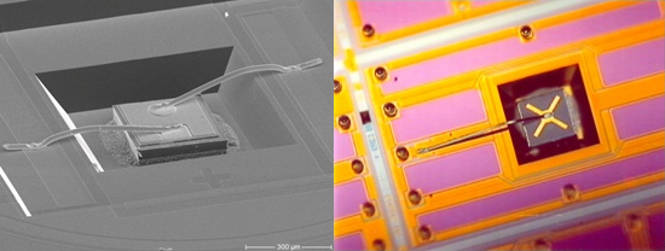Photodiode array with hybrid integrated illumination source
“Advanced UV for Life” – this is the name of the consortium that will open up innovative applications of UV light in medicine, water treatment, production technology and sensor technology in the future. The interdisciplinary consortium of 8 research institutions and 14 industrial companies is one of the 10 winners in the Twenty20 competition, which is part of the high-tech strategy of the German Federal Ministry of Education and Research (BMBF). This was announced by Federal Minister Johanna Wanka at a press conference.
UV radiation is more energetic than visible light. Its energy is sufficient to destroy chemical bonds or to create reaction partners and enable them to form new bonds. When chemical and biological processes are controlled by the effects of radiation, the use of chemicals can be completely eliminated.
The aim of the project is to develop novel semiconductor-based UV LED light sources with tailored properties. Thus, these novel light sources could be used for the following fields of application:
- Medicine and medical technology (e.g. dermatology, phototherapy, blood analysis, germ detection),
- Water treatment (e.g. drinking water, wastewater recycling),
- Production technology (e.g. UV curing for printing technology and sewer rehabilitation),
- Sensor technology (e.g. gas measurement technology, environmental measurement technology, UV monitoring).
“This commitment is a great success for all participating institutions,” explains consortium spokesman and director of Berlin’s Ferdinand Braun Institute Prof. Dr. Günther Tränkle. “Together, we can now consolidate our activities in the field of semiconductor-based UV light sources and make them useful for a wide range of applications – in any case, the right partners are on board and we are open to further collaborations.”
The partners serve the entire value chain, from materials research to device manufacturing and system integration to end applications.
CiS is jointly responsible for the development of integrable optical and impedimetric sensors as well as the construction of microsystems based on UV LED components and Si detectors for UV radiation.
The focus is on applications in medicine and medical technology. In particular, new diagnostic systems are needed for precise diagnostics of germ colonization on the skin, which can reliably and quickly determine the quality and quantity of germs. This requires new miniaturized UV technologies coupled with biomedical sensors.
Sensor solutions are needed that use various optical spectroscopic methods such as UV emission, fluorescence or impedance spectroscopy as a multi-sensor system. The clinical evaluation of these applications is performed by the Charité. CiS is the partner in the consortium in the field of microsystems technology.




